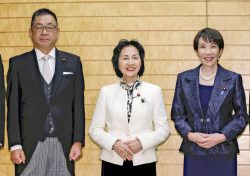
A long line for taxis forms of JR Kyoto Station
8:00 JST, January 6, 2024
Tourism is recovering quickly in the wake of the coronavirus disaster. As the influence of inbound travel on the economy increases, negative impacts on the natural environment and the lives of local people are becoming apparent in areas with excessive concentrations of travelers. In response, there is a growing movement to promote sustainable tourism for the benefit of both residents and tourists. More and more travelers want to have a positive impact on the culture, economy and environment of local communities through their travels, and they want to make more sustainable choices about where to go, where to stay, and how to get there. A key to growth will be a shift to a “staying tour” model that encourages people to stay in one place to enjoy the lifestyle rather than playing geographical hopscotch.
According to the Japan National Tourist Organization, an estimated 2,516,500 foreign tourists visited Japan in October 2023. This is the first time for the monthly figure to surpass the tally from the same month before the pandemic, and visitor arrivals look to remain steady in 2024.
On the other hand, in some areas and at certain times of day, there are concerns about the impact on the lives of residents due to excessive disorder and bad manners. There has also been a decline in traveler satisfaction. Adopting a “sustainable tourism” approach, which aims to preserve destinations in their original state and mutually enrich all stakeholders, including tourists, residents and businesses, is essential.
The World Tourism Organization, a U.N. body, defines sustainable tourism as being compatible with the needs of visitors, industry, the environment and the host region while fully considering current and future environmental, sociocultural and economic impacts. Tourism should develop the local economy while protecting the local community, natural environment and culture. It is a form of tourism that considers not only the present but also the future.
In 2023, the Japanese government announced its New Tourism Nation Promotion Basic Plan. The plan aims to shift from quantity to quality in its tourism strategy, to increase not just the number of tourists but also the amount they spend. It lists three strategies: “Create Sustainable Tourism Destinations,” “Recover Inbound Tourism” and “Expand Domestic Exchanges.”
Over the past 10 years, the number of repeat visitors to Japan has increased, and the percentage of foreign visitors who have visited Japan twice or more is expected to exceed 70% when the final numbers are in for fiscal 2022. Unlike domestic visitors, who often make one- or two-night trips, the average stay for foreign visitors is more than seven nights. After visiting famous tourist attractions and shopping, they are increasingly interested in learning about traditional Japanese culture and lifestyles.
Ozu, Ehime Prefecture, is a castle city with a historic townscape featuring traditional wooden townhouses called machiya. A machiya demolition crisis prompted a public-private partnership to restore and revitalize scattered vacant houses into lodgings, restaurants and general merchandise stores. The “Ozu Castle Stay,” in which visitors can stay at the castle at a cost of more than ¥1 million per night, has successfully drawn public attention. The castle hotel is a popular destination for inbound visitors, with employees dressed as warriors picking them up at the airport and dressing them up as a lord, lady or princess.
In addition to these efforts, hotel staff, business owners and government officials have come together for training on topics such as sustainable tourism. And they have an annual symposium for citizens, where they report on the status of the city’s development.
In March, Ozu was selected by Green Destinations of the Netherlands, an international certification organization, as one of the “Top 100 Sustainable Tourism Destinations in the World” for the second consecutive year. In March, it became the first Japanese city to win global first place in the “Culture & Tradition” category at the “Green Destinations Story Awards ITB Berlin” held in Germany.
The development and use of tourism NFTs (non-fungible tokens) is also progressing as a mechanism to promote “responsible tourism” that prevents “over-tourism” that negatively affects the lives of residents and takes into consideration the local community. In some regions, tourists earn NFTs by participating in activities that help solve local problems and can show their NFTs to receive “eco-friendly” benefits, such as a free drink at a local restaurant.
In Booking.com’s 2021 survey, 81% of global travelers said they want to stay in sustainable accommodations, and 43% said they want to support local communities and economies by being mindful of their travel-related choices. The “responsible traveler,” who takes responsibility for their actions and visits destinations with respect, is the new global travel trend. These travelers will continue to grow domestically and internationally and will be a source of sustainability for destinations.
Promotional material for tourism in Sakai City, Osaka Prefecture, asserts: “In the past, Japan had samurai. These warriors carried swords that could cut well — the tradition of their skills is in Sakai.”
Tourism strategies based on tradition and fostering civic pride among local residents have increased the number of inbound visitors who come to experience “knife sharpening.” The experience costs more than ¥10,000, and has led to the revitalization of traditional industries.
The Internal Affairs and Communications Ministry’s Standard Industrial Classification does not classify “tourism” as an independent category. There are only discrete related categories, such as land transportation, rail transportation, travel and lodging. The essence of the tourism industry is its broad base that generates consumption in a wide range of sectors, from primary to tertiary, and creates new value. The vast industry base, which is so broad that it is difficult to grasp, opens up opportunities for various people, companies and municipalities. It is essential to appreciate inbound tourism while protecting tourism resources and respecting the identity of residents. It is also crucial to work to achieve both. Fostering the sentiment of residents that “it is good to live here and even better to have visitors” will create sustainable tourism and make it the driving force behind the revitalization of local communities.
Political Pulse appears every Saturday.

Shingo Sugime
Sugime is a staff writer in the Economic News Department of The Yomiuri Shimbun Osaka.
"Editorial & Columns" POPULAR ARTICLE
-

Violations of Subcontract Law: Major Automakers Must Eliminate Old Practices
-

Local Governments’ Tax Revenues: Devise Ways to Correct Imbalances in Tax Sources
-

5 Japanese Business Dinner Mistakes to Avoid — and What They Taught Me About Business in Japan
-

Heavy Rains in Asia: Support for Victims, Flood-Control Measures Urgently Needed
-

New Nuclear Threat: China Seeking to Follow U.S., Russia in Military Expansion
JN ACCESS RANKING
-

Keidanren Chairman Yoshinobu Tsutsui Visits Kashiwazaki-Kariwa Nuclear Power Plant; Inspects New Emergency Safety System
-

Imports of Rare Earths from China Facing Delays, May Be Caused by Deterioration of Japan-China Relations
-

University of Tokyo Professor Discusses Japanese Economic Security in Interview Ahead of Forum
-

Japan Pulls out of Vietnam Nuclear Project, Complicating Hanoi’s Power Plans
-

Govt Aims to Expand NISA Program Lineup, Abolish Age Restriction

























